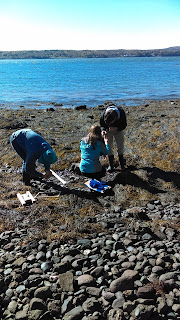Wow! The wonderful Bell High School teachers have been bringing students to the
Huntsman Marine Science Centre for 17 years! Below are some pictures from this year's awesome marine biology field trip.
Having fun in the rain exploring the diversity of animals living in the intertidal zone.
Lots of animals hiding under the rocks, including these small sea stars.
Collecting plankton while on the research vessel.
Learning about the animals living on the bottom of the bay.
Two adorable tiny scallops.
A large Jonah crab.
Beautiful morning on the mud flats.
Searching for marine worms.
Blood worm.
The students in the lab observing the live animals they collected from the boat and beach.
Studying the anatomy of a sea urchin.
The students visited Grand Manan Island to go whale watching with
Sea Watch Tours. They saw some humpbacks that were very active at the surface.
Also, they were very lucky to see Old Thom, an orca whale that is occasionally spotted in the Bay of Fundy. Exciting!!
On the hunt for invasive green crabs.
One of the 257 crabs the students found.
Data on the size and gender of each crab is collected.
Also, found a porpoise skull...
and spine on the beach.
Experiment day! Students were determining if size affected the flipping rate of urchins ...
or sea stars.
Other students tested the strength of echinoderms...
or how temperature effects the feeding rate of barnacles.























































